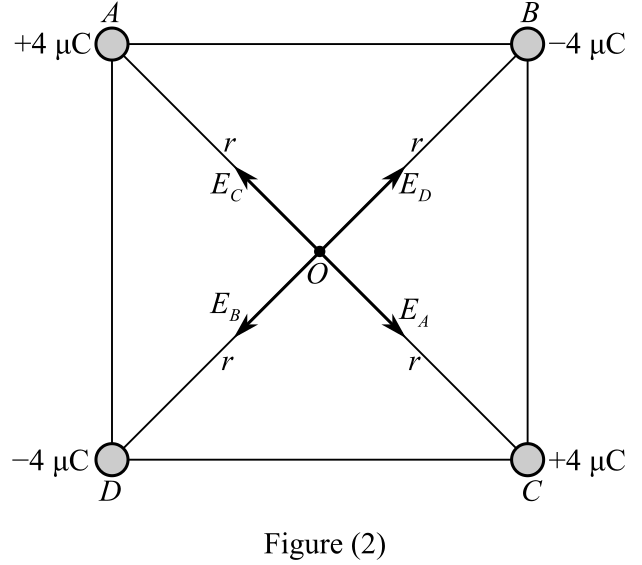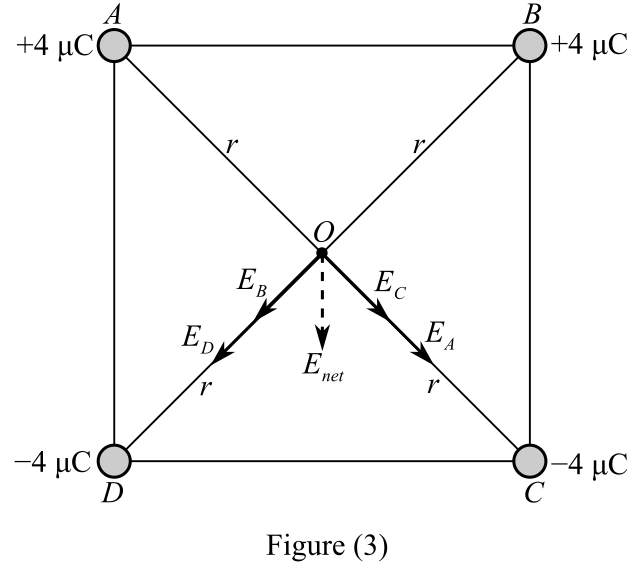
Concept explainers
Four equal-magnitude (4.0
(a)
The electric field at the center of the square, iffour positively charged charges, having magnitude of each is
Answer to Problem 42SP
Solution:
Explanation of Solution
Given data:
The length of each side of the square is
The magnitude of each charge is
Formula used:
Write the expression for the electric field
Here,
Explanation:
In this case, all charges are of equal magnitude and polarity, and are located at the same distance from the center of the square.
Denote the charge by
As all charges are positive, the direction of the electric field shall be outward and away from the charges, as shown in the figure below.
The electric field at the center of the square will the resultant electric filed due to all the electric fields acting on it. Therefore, the electric field at the center of the square will be the resultant of the electric fields due to charges at points A, B, C, and D.

Recall the expression for the electric field.
Refer to the above diagram and write the expression for the electric field at the corners of the square due to all the four-point charges that are placed at the corners of the square.
Write the expression for the electric field due to charges at the point A.
Write the expression for the electric field due to charges at the point B.
Write the expression for the electric field due to charges at the point C.
Write the expression for the electric field due to charges at the point D.
The resultant electric field at the center of the square will be
Substitute
Conclusion:
The electric field at the center of the square if the charges are all positive is
(b)
The electric field at the center of the square if the charges alternate in sign around the perimeter of the square and the magnitude of each charge is
Answer to Problem 42SP
Solution:
Explanation of Solution
Given data:
The length of each side of the square is
The magnitude of each charge is
Formula used:
Write the expression for the electric field
Here,
Explanation:
In this case, all charges are of equal magnitude, however, they are placed such that they alternate in sign around the perimeter of the square. Also, they are located at the same distance from the center of the square.
Denote the charge by
For positivecharges, the direction of the electric field shall be outward and away from the charges, while for negative charges the direction of the electric field shall be toward the charges as shown in the figure below.
The electric field at the center of the square will be the resultant electric filed due to all the electric fields acting on it. Therefore, the electric field at the center of the square will be the resultant of the electric fields due to charges at points A, B, C and D.

The expression for the electric field is given as
Here,
Write the expression for the electric field due to charges at the point A.
Write the expression for the electric field due to charges at the point B.
Write the expression for the electric field due to charges at the point C.
Write the expression for the electric field due to charges at the point D.
The resultant electric field at the center of the square will be
Substitute
Conclusion:
The electric field at the center of the square, if the charges alternate in sign around the perimeter of the square, is
(c)
The electric field at the center of the square if the all the four charges, having magnitude of each as
Answer to Problem 42SP
Solution:
Explanation of Solution
Given data:
The length of each side of the square is
The magnitude of each charge is
Formula used:
Write the expression for the electric field.
Here,
Write the expression for the relation between the length of the diagonal and side of a square
Here,
Write the expression for the net (resultant) electric field
Here,
Explanation:
In this case, all charges are of equal magnitude, however, they are placed such the charges on the top are positive while the charges on the bottom are negative. Also, they are located at the same distance from the center of the square.
Denote the charge by
For positive charges, the direction of the electric field shall be outward and away from the charges, while for negative charges the direction of the electric field shall be toward the charges, as shown in the figure below.
The electric field at the center of the square will be the resultant electric filed due to all the electric fields acting on it. Therefore, the electric field at the center of the sphere will be the resultant of the electric fields due to charges at points A, B, C and D.

Recall the expression for diagonal length of a square.
Here,
Apply the equation mentioned above to determine the distance
Write the expression for distance
Substitute
Write the expression for the electric field.
Here,
Refer to the above diagram and write the expression for the electric field due to charges at A, B, C and D.
Write the expression for the electric field due to charges at the point A.
Write the expression for the electric field due to charges at the point B.
Write the expression for the electric field due to charges at the point C.
Write the expression for the electric field due to charges at the point D.
Recall the expression for the resultant electric field at the center of the square.
The angle between sum of electric field due to C and A, and D and B is
Substitute
Understand that
Substitute
Conclusion:
The electric field at the center of the square if the charges follow the sequence plus, plus, minus, minus around the perimeter of the square is
Want to see more full solutions like this?
Chapter 24 Solutions
Schaum's Outline of College Physics, Twelfth Edition (Schaum's Outlines)
Additional Science Textbook Solutions
The Physical Universe
Life in the Universe (4th Edition)
University Physics Volume 1
MODERN PHYSICS (LOOSELEAF)
Glencoe Physics: Principles and Problems, Student Edition
Physics for Scientists and Engineers with Modern Physics
- A circular ring of charge with radius b has total charge q uniformly distributed around it. What is the magnitude of the electric field at the center of the ring? (a) 0 (b) keq/b2 (c) keq2/b2 (d) keq2/b (e) none of those answersarrow_forwardA circular ring of charge of radius b has a total charge q uniformly distributed around it. Find the magnitude of the electric field in the center of the ring. (a) 0 (b) keq/b2 (c) keq2/b2 (d) keq2/b (e) None of these answers is correct.arrow_forwardIn nuclear fission, a nucleus of uranium-238, which contains 92 protons, can divide into two smaller spheres, each having 46 protons and a radius of 5.90 1015 m. What is the magnitude of the repulsive electric force pushing the two spheres apart?arrow_forward
- A 1.75-nC charged particle located at the origin is separated by a distance of 0.0825 m from a 2.88-nC charged particle located farther along the positive x axis. If the 1.75-nC particle is kept fixed at the origin, where along the positive x axis should the 2.88-nC particle be located so that the magnitude of the electrostatic force it experiences is twice as great as it was in Problem 27?arrow_forwardA point charge of 4.00 nC is located at (0, 1.00) m. What is the x component of the electric field due to the point charge at (4.00, 2.00) m? (a) 1.15 N/C (b) 0.864 N/C (c) 1.44 N/C (d) 1.15 N/C (e) 0.864 N/Carrow_forwardaA plastic rod of length = 24.0 cm is uniformly charged with a total charge of +12.0 C. The rod is formed into a semicircle with its center at the origin of the xy plane (Fig. P24.34). What are the magnitude and direction of the electric field at the origin? Figure P24.34arrow_forward
- Is it possible for a conducting sphere of radius 0.10 m to hold a charge of 4.0 C in air? The minimum field required to break down air and turn it into a conductor is 3.0 106 N/C.arrow_forwardTwo solid spheres, both of radius 5 cm, carry identical total charges of 2 C. Sphere A is a good conductor. Sphere B is an insulator, and its charge is distributed uniformly throughout its volume. (i) How do the magnitudes of the electric fields they separately create at a radial distance of 6 cm compare? (a) EA EB = 0 (b) EA EB 0 (c) EA = EB 0 (d) 0 EA EB (e) 0 = EA EB (ii) How do the magnitudes of the electric fields they separately create at radius 4 cm compare? Choose from the same possibilities as in part (i).arrow_forwardA particle with charge q on the negative x axis and a second particle with charge 2q on the positive x axis are each a distance d from the origin. Where should a third particle with charge 3q be placed so that the magnitude of the electric field at the origin is zero?arrow_forward
- Three charged particles are located at the corners of an equilateral triangle as shown in Figure P19.9. Calculate the total electric force on the 7.00-C charge.arrow_forwardConsider the charge distribution shown in Active Figure 19.31. (i) What are the charges contributing to the total electric flux through surface S? (a) q1 only (b) q4 only (c) q2 and q3 (d) all four charges (e) none of the charges (ii) What are the charges contributing to the total electric field at a chosen point on the surface S? (a) q1 only (b) q4 only (c) q2 and q3 (d) all four charges (e) none of the charges Active Figure 19.31 The net electric flux through any closed surface depends only on the charge inside that surface. The net flux through surface S is ql/0, the net flux through surface S is (q2 + q3)/0, and the net flux through surface S is zero.arrow_forward
 Principles of Physics: A Calculus-Based TextPhysicsISBN:9781133104261Author:Raymond A. Serway, John W. JewettPublisher:Cengage Learning
Principles of Physics: A Calculus-Based TextPhysicsISBN:9781133104261Author:Raymond A. Serway, John W. JewettPublisher:Cengage Learning Physics for Scientists and Engineers: Foundations...PhysicsISBN:9781133939146Author:Katz, Debora M.Publisher:Cengage Learning
Physics for Scientists and Engineers: Foundations...PhysicsISBN:9781133939146Author:Katz, Debora M.Publisher:Cengage Learning Physics for Scientists and Engineers with Modern ...PhysicsISBN:9781337553292Author:Raymond A. Serway, John W. JewettPublisher:Cengage Learning
Physics for Scientists and Engineers with Modern ...PhysicsISBN:9781337553292Author:Raymond A. Serway, John W. JewettPublisher:Cengage Learning Physics for Scientists and EngineersPhysicsISBN:9781337553278Author:Raymond A. Serway, John W. JewettPublisher:Cengage Learning
Physics for Scientists and EngineersPhysicsISBN:9781337553278Author:Raymond A. Serway, John W. JewettPublisher:Cengage Learning Physics for Scientists and Engineers, Technology ...PhysicsISBN:9781305116399Author:Raymond A. Serway, John W. JewettPublisher:Cengage Learning
Physics for Scientists and Engineers, Technology ...PhysicsISBN:9781305116399Author:Raymond A. Serway, John W. JewettPublisher:Cengage Learning College PhysicsPhysicsISBN:9781305952300Author:Raymond A. Serway, Chris VuillePublisher:Cengage Learning
College PhysicsPhysicsISBN:9781305952300Author:Raymond A. Serway, Chris VuillePublisher:Cengage Learning





